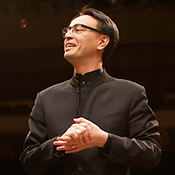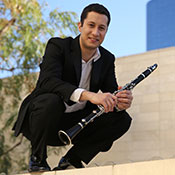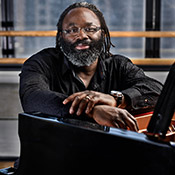
Pianist Stewart Goodyear Joins the MSO for Liszt
David Lewellen
PUBLISHED
Tagged Under: 2023.24 Season, Guest Artist, piano
Pianist Stewart Goodyear will perform two works by Franz Liszt with the MSO April 26-28 on a program that includes Berlioz’s Symphonie fantastique. Goodyear, who is also an active composer, recently spoke with Backstage writer David Lewellen about composition, staying in the moment, and musical influences. An edited version follows.
Q. What is your origin story for becoming a musician?
A. Music was always my heartbeat. I always had a classical music soundtrack in my head when I was walking to or at school. I decided that I wanted to be a pianist when I was around four. I could already play by ear, and I loved performing for people.
Q. What about composition?
A. My first composition was when I was eight, for choir. I wanted to be a composer who wrote cantatas and symphonies. It’s an equal passion to performing.
Q. How do you divide your time?
A. I compose in the morning and practice at night. But sometimes I’ll improvise as a warmup, and that idea will become the basis for a composition. When I’m out for a walk or traveling, I keep manuscript paper with me in case I get an idea.
Q. Manuscript paper?
A. Yes, I’m still a paper and pencil guy. I get more ideas from the physical act of writing.
Q. How does a pianist warm up?
A. I try not to overfocus. All the homework is done before I arrive at the city for the concert. I try to meditate at the hotel to be as relaxed as possible.
Q. Can you be relaxed while you play intense music like Liszt’s?
A. I’ve trained myself so my body has the freedom to be exciting or intense. You can bring more power to it if you’re not focused on phrasing or technique and you’re just telling the story.
Q. How does the meditative state play out in rehearsal, when you’re working with other people?
A. It’s collaborative, and I’m always looking to give and receive. If the orchestra phrases something a certain way, it’s up to me to honor that phrasing. There’s telepathy between everyone. We create a postcard-like performance of that time and place.
Q. What do you mean by postcard-like?
A. It’s about the here and now, and it brings intensity. We’re here, and we’ll never get this exact chance again.
Q. Tell me a little about the Liszt pieces you’ll be playing.
A. The electricity Liszt had as a performer is well-documented. There’s a sense of danger in the music. It takes everyone to different places and levels of emotion. And the nuances of Liszt are different from the nuances of Debussy, for instance. I feel like a character actor for every composer I perform.
Q. What are some of your influences as a composer?
A. Whether we admit it or not, composers are inspired by past greatness. Definitely Liszt, the way he brings out voices and colors in the orchestra. The orchestra was also his instrument. Beethoven, Brahms, Ravel – they were all pianists and also great orchestrators. You have to know every instrument fully and have a sense of its texture and color and focus on its strengths. But I’ve also been influenced by calypso and jazz, the language of the 21st century.
Q. Tell me more about that.
A. My mother was Trinidadian and my father was British. I grew up listening to The Who, The Beatles, and The Rolling Stones. I’m composing in a classical sound world, but my ethnic background seeps into everything I compose. It was the same for Liszt and for Berlioz. The Symphonie fantastique is very French. You couldn’t say it was from any other country.
Q. Have you played with the MSO before?
A. Yes, but it’s been a while. I did Rhapsody in Blue with Kristjan Järvi, maybe in 2009. It’s such a pleasure to be back with this great orchestra.



